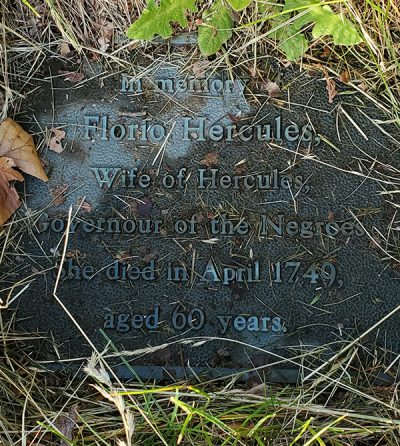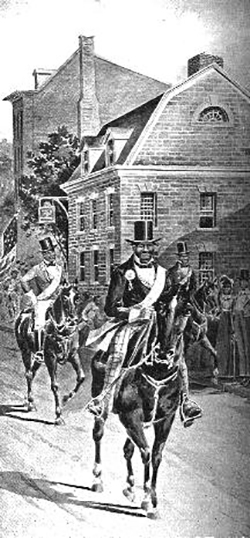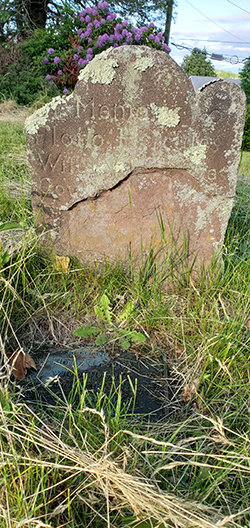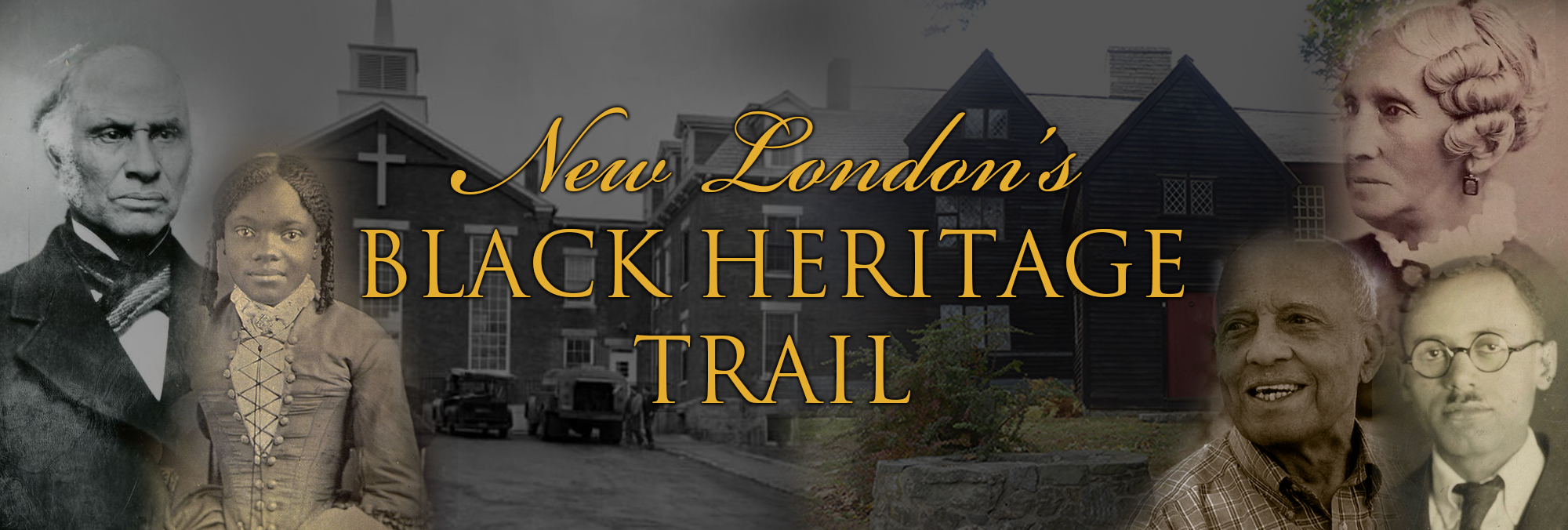
A bronze plaque augments Florio’s deteriorated gravestone. Photo by Nicole Thomas.
Florio, Hercules and Connecticut’s Black Governors
By Nicole Thomas
In the lower part of Ye Antientest Burial Place in New London, in the section where early Black residents are buried, a crumbling gravestone reads, “Here lies Florio Hercules, wife of Hercules, Governour of the Negroes.” This gravestone, installed after Florio’s death in 1749 at the age of sixty, is the earliest evidence of Connecticut’s Black governors. Although Hercules’s election doesn’t show up in any known documents, Florio’s gravestone arguably makes him Connecticut’s earliest known Black governor.
History of Connecticut’s Black governors
Connecticut’s Black governors didn’t hold statewide office. Rather, they were Black men elected by a region or town’s Black residents. In New England, the election of Black governors or kings, as they were known in several colonies, began in Lynn, Massachusetts in the early 1740s. Within a few decades, the tradition had spread to New Hampshire, Rhode Island and Connecticut.
In Connecticut, when white colonists traveled to Hartford to elect their governor, the enslaved travelled with them and held their own elections. As the Black population grew, the election of Black governors became a local celebration, held outdoors in keeping with African customs.
In addition to choosing their governor, attendees played games, held contests, and danced to their traditional music. Celebrants wore fancy clothes, sometimes donated for the occasion by their enslavers. After the election results were announced, the newly elected governor would lead a parade through town on horseback. The day ended with a feast, often subsidized by the winning candidate’s enslaver.
Although some white New Englanders described Black governors as men who commanded respect, others disparaged both the governors and election day celebrations. Frances M. Caulkins wrote that “Sam Hun’ton was annually elected to this mock dignity for a greater number of years, than his honorable namesake and master Samuel Huntington, Esq. filled the gubernatorial chair. It was amusing to see this sham dignitary after his election, riding through town on his master’s horses ….”

Parade of the ‘Black Governors’ in Hartford by H. P. Arms c. 1905.
However, William D. Piersen wrote that “the office did confer great honor and dignity … many Africans recognized themselves as coming from a social class above their masters, while others saw themselves as morally superior … The Black governors personified this dignity of the black community, and the bearing of the rulers reflected the personal self-respect and pride of the men chosen.”
Black governors enforced laws and mediated disputes between the Black and white communities, sometimes appointing lieutenant governors and deputies to help with their responsibilities. Certainly, there were limitations to their power: they did not write the laws they enforced, nor did they have the authority to discipline white residents who committed crimes against Black residents. Thus, some sources interpret the Black governors’ role as a way of maintaining white control while creating a buffer between the Black and white communities.
But Connecticut’s Black governors were not merely keepers of the status quo. They were true leaders, chosen for their oratory skills, physical strength, commitment to their community, and status–either of their enslavers if they were enslaved or their own, based on military service, accomplishments or the status of their African ancestors.
Although we don’t know much about many of the Black governors, we know that some were strong advocates for social change. For example, from 1814, when Connecticut first passed legislation restricting voting rights to white men, to 1870 when the passage of the 15th Amendment granted Black men the right to vote, multiple Black governors petitioned Connecticut’s General Assembly for voting rights. Borrowing from the Founding Fathers, they argued that they were being unfairly taxed without representation.
Such advocacy was risky. For example, in 1814, when New Haven’s Black governor William Lanson petitioned the state to either grant Black New Haven men the right to vote or exempt them from paying taxes, white authorities responded by levying fines, arresting him without charges and seizing his property.
The tradition of electing Black governors in Connecticut waned during the second quarter of the 19th century. Connecticut’s last known Black governor was Wilson Westone, elected in Seymour around 1855.

Florio’s gravestone. Photo by Nicole Thomas.
Florio and Hercules
Although Hercules was the earliest known Black governor in Connecticut, we know little about him or his family. The enslaved were often listed in property inventories or wills only by age and gender, and the Federal Census didn’t keep records of their full names until after Connecticut had abolished slavery.
We don’t know who enslaved Hercules, although we know that Florio (sometimes known as Flora) was enslaved by the Hallum family in New London. We don’t know when Hercules died or where he was buried.
We know that Florio and Hercules had two children: a daughter, Judith, and a son, Abraham Hercules. On May 30th, 1756, Joshua Hempsted mentioned Abraham Hercules’s death in his diary, simply stating “Abrha Herculas Samll Lattimers negro man died this morning aged 20 odd.” Frances Manwaring Caulkins wrote in her history of New London that in September 1714, Hallam’s “wife disposes of her negro woman Flora, and girl, Judith.”
Because we have no evidence that Hercules ever lived in the same household as Florio, and because he isn’t buried with her in Ye Antientest Burial Place, we can surmise that enslavement separated them in both life and death.
Nonetheless, the inscription on Florio’s gravestone survives as a testament to Hercules’ stature in New London’s Black community, and to a time when Connecticut’s enslaved population resisted their exclusion from colonial leadership by electing leaders of their own
For further reading:
https://www.newenglandhistoricalsociety.com/black-kings-governors-new-england/
https://www.courant.com/news/connecticut/hc-xpm-2006-08-29-0608290738-story.html
I. Frances Manwaring Caulkins, The History of Norwich, Connecticut: From Its Settlement in 1660, to January 1845. (Norwich, CT: Thomas Robertson, 1845), 185.
II. William D. Piersen, Black Yankees: The Development of an Afro-American Subculture in Eighteenth-Century New England (Amherst, MA: 1988), 132. Link
III. Andy Piascik, “Connecticut’s Black Governors,” Connecticut History.org, February 26, 2021,
IV. Katherine J. Harris, “No taxation without Representation”: Black Voting in Connecticut,” Connecticut Explored, Spring, 2016. Link
V. Barbara W. Brown and James M. Rose, Black Roots in Southeastern Connecticut. (New London, CT: The New London County Historical Society, 2001), 505.
VI. Ibid
VII. Frances Manwaring Caulkins, History of New London Connecticut: From the First Survey of the Coast in 1612 to 1860. (New London: New London county Historical Society, 2007), 359.

Joshua Hempsted’s will, photo courtesy the Hempsted Houses, New London, owned and operated by Connecticut Landmarks.

